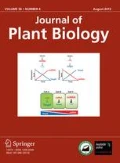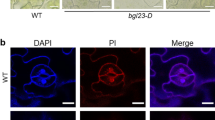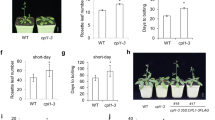Abstract
The apetala3 (ap3)-like homeotic mutation (ap3-HM) is recognized among pD991-AP3-derived Arabidopsis thaliana T-DNA-tagged lines carrying the -448 to +47 region of AP3 in their T-DNA. In the corresponding mutant lines for CTP:phosphorylcholine cytidylyltransferase genes, cct1-1 and cct2 (Inatsugi et al. 2009), some flowers of cct1-1 (F4) and many flowers of cct1-1 cct2 (F3) showed ap3-HM, and all flowers of cct1-1 (F5) and cct1-1 cct2 (F4) became increasingly homeotic. In contrast, cct2 flowers were normal for all generations tested. These results demonstrated that ap3-HM is linked to the cct1-1 allele and is enhanced by the cct2 allele. The ap3-HM in cct mutants was inversely correlated with AP3 transcript levels in enriched flower buds. Bisulfite sequencing revealed severe methylation within endogenous AP3 promoter regions in cct1-1 (F3; -317 to -2) and cct1-1 cct2 (F3; -473 to -2), but wild-type (Wassilevskaja) and cct2 plants showed no corresponding methylation. The ap3-HM in cct1-1 cct2 mutants was fully rescued by expressing a PISTILLATA promoter–AP3 construct, and was better alleviated in the F1 offspring of a cross with the CCT1-overexpressing mutant cct1-2 (Columbia) than with the wild type. We discuss possible links between expression of CCT and suppression of ap3-HM.
Similar content being viewed by others
Abbreviations
- AP3 :
-
APETALA3
- CCT, CTP:
-
phosphorylcholine cytidylyltransferase
- Col:
-
Columbia
- GFP:
-
green fluorescent protein
- HDGS:
-
homologydependent gene silencing
- PI :
-
PISTILLATA
- ProAP3 :
-
AP3 promoter
- ProPI :
-
PI promoter
- Pro35S :
-
Cauliflower mosaic virus 35S promoter
- siRNA:
-
small interfering RNA
- WS:
-
Wassilevskaja
References
Bouchard E (2006) Charactérisation morphologique et cytogénétique de deux lignées D’Arabidopsis thaliana déficientes pour PMS1, une protéine du systéme de correction des mesappariements. Maitre és sciences (M.Sc.), Université Laval, Québec
Cavalli G (2002) Chromatin as a eukaryotic template of genetic information. Curr Opin Cell Biol 14:269–278
Chae E, Tan QKG, Hill TA, Irish VF (2008) An Arabidopsis F-box protein acts as a transcriptional co-factor to regulate floral development. Development 135:1235–1245
Chan SW, Henderson IR, Jacobsen SE (2005) Gardening the genome: DNA methylation in Arabidopsis thaliana. Nat Rev Genet 6: 351–360
Clough SJ, Bent AF (1998) Floral dip: A simplified method for Agrobacterium-mediated transformation of Arabidopsis thaliana. Plant J 16:735–743
Davies GJ, Sheikh MA, Ratcliffe, O.J, Coupland G, Furner IJ (1997) Genetics of homology-dependent gene silencing in Arabidopsis: a role for methylation. Plant J 12:791–804
Depicker A, Van Montagu M (1997) Post-transcriptional gene silencing in plants. Curr Opin Cell Biol 9:373–382
Frommer M, McDonald LE, Millar DS, Collis CM, Watt F, Grigg GW, Molloy PL, Paul CL (1992) A genomic sequencing protocol that yields a positive display of 5-methylcytosine residues in individual DNA strands. Proc Natl Acad Sci USA 89:1827–1831
Goto K, Meyerowitz EM (1994) Function and regulation of the Arabidopsis floral homeotic gene PISTILLATA. Genes Dev 8:1548–1560
Hajdukiewicz P, Svab Z, Maliga P (1994) The small, versatile pPZP family of Agrobacterium binary vectors for plant transformation. Plant Mol. Biol 25:989–994
Hill JP, Lord EM (1989) Floral development in Arabidopsis thaliana: a comparison of the wild type and homeotic gene pistillata mutant. Can J Bot 67:2922–2936
Hill TA, Day CD, Zondlo SC, Thackeray AG, Irish VF (1998) Discrete spatial and temporal cis-acting elements regulate transcription of the Arabidopsis floral homeotic gene APETALA3. Development 126:1711–1721
Honma T, Goto K (2001) Complexes of MADS-box proteins are sufficient to convert leaves into floral organs. Nature 409:525–529
Houweling M, Cui Z, Abfuso CD, Bussiere M, Chen MH, Vance DE (1996) CTP-phosphocholine cytidylyltrasferase is both a nuclear and cytoplasmic protein in primary hepatocytes. Eur J Cell Biol 69:55–63
Inatsugi R, Nakamura M, Nishida I (2002) Phosphatidylcholine biosynthesis at low temperature: Differential expression of CTP: phosphorylcholine cytidylyltransferase isogenes in Arabidopsis thaliana. Plant Cell Physiol 43:1342–1350
Inatsugi R, Kawai H, Yamaoka Y, Yu Y, Sekiguchi A, Nakamura M, Nishida I (2009) Isozyme-specific modes of activation of CTP: phosphorylcholine cytidylyltransferase in Arabidopsis thaliana at low temperature. Plant Cell Physiol 50:1727–1735
Jack T, Brockman LL, Meyerowitz EM (1992) The homeotic gene apetala3 of Arabidopsis thaliana gene encodes a MADS-boxand is expressed in petals and stamens. Cell 68:683–697
Jack T, Fox GL, Meyerowitz EM (1994) Arabidopsis homeotic gene APETALA3 ectopic expression: Transcriptional and posttranscriptional regulation determine floral organ identity. Cell 76:703–716
Kosugi S, Hasebe M, Tomita M, Yanagawa H (2009) Systematic identification of yeast cell cycle-dependent nucleocytoplasmic shutting proteins by prediction of composite motifs. Proc Natl Acad Sci USA 106:10171–10176
Meyer P, Saedler H (1996) Homology-dependent gene silencing in plants. Annu Rev Plant Rev Plant Mol Biol 47:23–48
Miura A, Yonebayashi S, Watanabe K, Toyama T, Shimada H, Kakutani T (2001) Mobilization of transposons by a mutation abolishing full DNA methylation in Arabidopsis. Nature 411:212–214
Nakagawa T, Kurose T, Hino T, Tanaka K, Kawamukai M, Niwa Y, Toyooka K, Matsuoka K, Jinbo T, Kimura T (2007) Development of series of gateway binary vectors, pGWBs, for realizing efficient construction of fusion genes for plant transformation. J Biosci Bioeng 1:34–41
Nakai K, Kanehisa M (1992) A knowledge base for predicting protein localization sites in eukaryoteic cells. Genomics 14:897–911
Nakamura Y, Andrés F, Kanehara K, Liu YC, Dorman P, Coupland G (2014) Arabidopsis florigen FT binds to diurnally oscillating phospholipids that accelerate flowering. Nat Commun 5:3553
Nerlich A (2007) Die Rolle der Phosphatidylserin Decarboxylase für die mitochondriale Phospholipid-Biosynthese in Arabidopsis thaliana. Dissertation zur Erlangung des akademischen Grades “doctor rerum naturalium” in der Wissenschaftsdisziplin “Biochemie”. Mathematisch-Naturwissenschaftlichen Fakultät der Universität Potsdam
Niwa Y, Hirano T, Yoshimoto K, Shimizu M, Kobayashi H (1999) Non-invasive quantitative detection and applications of nontoxic, S65T-type green fluorescent protein in living plants. Plant J 18:455–463
Oikawa A, Otsuka T, Jikumaru Y, Yamaguchi S, Matsuda F, Nakabayashi R, Takashina T, Isuzugawa K, Saito K, Shiratake K (2011) Effect of freeze-drying of samples on metabolite levels in metabolome analyses. J Sep Sci 34:3561–3567
Paszkowski J, Whitham SA (2001) Gene silencing and DNA methylation processes. Curr Opin Plant Biol 4:123–129
Stam M, Mol JNM, Kooter JM (1997) The silence of genes in transgenic plants. Ann Bot 79:1–12
Sussman MR, Amasino RM, Young JC, Krysan PJ, Austin-Phillips S (2000) The Arabidopsis knockout facility at the university of Wisconsin–Madison. Plant Physiol 124:1465–1467
Smyth DR, Bowman JL, Meyerowitz EM (1990) Early flower development in Arabidopsis. Plant Cell 2:755–767
Sung S, He Y, Eshoo TW, Tamada Y, Johnson L, Nakagoshi K, Goto K, Jacobsen SE, Amashino RM (2006) Epigenetic maintenance of the vernalized state in Arabidopsis thaliana requires LIKE HETEROCHROMATIN PROTEIN1. Nature Genet 38:706–710
Tague BW, Mantis J (2006) In planta Agrobacterium-mediated transformation by vacuum infiltration. Methods Mol Biol 323:215–223
Tilly JJ, Allen DW, Jack T (1998) The CArG boxes in the promoter of the Arabidopsis floral organ identity gene APETALA3 mediate diverse regulatory effects. Development 125:1647–1657
Turck F, Roudier F, Farrona S, Martin-Magniette ML, Guillaume E, Buisine N, Gagnot S, Martienssen RA, Coupland G, Colot V (2007) Arabidopsis TFL/LHP1 specifically associates with genes marked by trimethylation of histone H3 lysine 27. PLoS Genet 3:0855–0866
van Tunen AJ, Mol JNM (1990) Control of flavonoid synthesis and manipulation of flower colour. In Developmental Regulation of Plant Gene Expression. Edited by Grierson, D. pp. 94–125, Blackie, City
Wang Y, MacDonald JI, Kent C (1995) Identification of the nuclear localization signal of rat liver CTP:phosphocholine cytidylyltransferase. J Biol Chem 270:354–360
Weigel D and Meyerowitz EM (1994) The ABCs of floral homeotic genes. Cell 78:203–209
Author information
Authors and Affiliations
Corresponding author
Electronic supplementary material
Rights and permissions
About this article
Cite this article
Hayakawa, Y., Duan, Z., Yadake, M. et al. Epigenetic floral homeotic mutation in pD991-AP3-derived T-DNA-tagged lines for CTP:Phosphorylcholine cytidylyltransferase (CCT) Genes: The homeotic mutation of the cct1-1 allele is enhanced by the cct2 allele and alleviated by CCT1 overexpression. J. Plant Biol. 58, 183–192 (2015). https://doi.org/10.1007/s12374-014-0587-y
Received:
Accepted:
Published:
Issue Date:
DOI: https://doi.org/10.1007/s12374-014-0587-y




